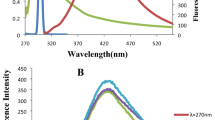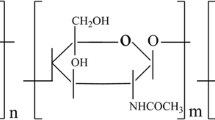Abstract
In this work, fluorescent carbon dots were synthesized from polyethylene glycol. The carbon dots are of sizes below 10 nm as confirmed through dynamic light scattering studies and transmission electron microscope images. Carbon dot was further conjugated with Ca2+ to form metal-ion-conjugated polyethylene glycol carbon dot. The metal-ion-conjugated polyethylene glycol carbon dot exhibits enhanced photoluminescence properties. Fluorescence of the Ca-modified carbon dots was quenched in the presence of Trifluralin. The practical utility of the system was demonstrated by using it to detect Trifluralin contaminated soil sample. Also, an array of sensor plates prepared using the drop-casting method on glass plates showed visual changes in fluorescence in the presence of Trifluralin. Development of such fluorescent-based detection system will lead to visual detection kits for detecting herbicides in general.
Graphical Abstract
We developed a fluorescent-based metal conjugated polyethylene glycol carbon dot (Ca-PEG-CD) that was used to detect Trifluralin herbicide.








Similar content being viewed by others
References
Xu X, Ray R, Gu Y, Ploehn HJ, Gearheart L, Raker K, Scrivens WA (2004) Electrophoretic analysis and purification of fluorescent single-walled carbon nano tube fragments. J Am Chem Soc 126:12736–12737
Majumdar S, Baruah U, Majumdar G, Thakur D, Chowdhury D (2016) Paper carbon dot based fluorescence sensor for distinction of organic and inorganic sulphur in analytes. RSC Adv 6:57327–57334
Li HL, Zhang YW, WangL Tian JQ, Sun XP (2011) Nucleic acid detection using carbon nanoparticles as a fluorescent sensing platform. Chem Commun 47:961–963
Huang P, Lin J, Wang X, Wang Z, Zhang C, He M, Wang K, Chen F, Li Z, Shen G, Cui D, Chen X (2012) Light-triggered theranostics based on photosensitizer-conjugated carbon dots for simultaneous enhanced-fluorescence imaging and photodynamic therapy. Adv Mater 24:5104–5110
Majumdar S, Krishnatreya G, Gogoi N, Thakur D, Chowdhury D (2016) Carbon-dot-coated alginate beads as a smart stimuli-responsive drug delivery system. ACS Appl Mater Interfaces 8:34179–34184
Bhati A, Anand SR, Kumar G, Garg A, Khare P, Sonkar SK (2018) Sunlight-induced photocatalytic degradation of pollutant dye by highly fluorescent red-emitting Mg–N-embedded carbon dots. ACS Sustain Chem 6:9246–9256
Li Y, Zhao Y, Cheng HH, Hu Y, Shi GQ, Dai LM, Qu LT (2012) Nitrogen-doped graphene quantum dots with oxygen-rich functional groups. J Am Chem Soc 134:15–18
Lim SY, Shen W, Gao Z (2015) Carbon quantum dots and their applications. Chem Soc Rev 44:362–382
Khattab TA, Kassem NF, Adel AM, Kamel S (2019) Optical recognition of ammonia and amine vapor using “turn-on” fluorescent chitosan nanoparticles imprinted on cellulose strips. J Fluoresc 29:693–702
Dong JX, Gao ZF, Zhang Y, Li BL, Li NB, Luo HQ (2017) A selective and sensitive optical sensor for dissolved ammonia detection via agglomeration of fluorescent Ag nanoclusters and temperature gradient headspace single drop microextraction. Biosens Bioelectron 91:155–161
Schaude C, Meindl C, Frohlich E, Attard J, Mohr GJ (2017) Developing a sensor layer for the optical detection of amines during food spoilage. Talanta 170:481–487
Hasanzadeh A, Khataee A, Zarei M, Joo SW (2018) Photo-assisted electrochemical abatement of trifluralin using a cathode containing a C60-carbon nanotubes composite. Chemosphere 199:510–523
Bouvier G, Blanchard O, Momas I, Seta N (2006) Pesticide exposure of non-occupationally exposed subjects compared to some occupational exposure: a French pilot study. Sci Total Environ 366:74–91
Topuz S, Ozhan G, Alpertunga B (2005) Simultaneous determination of various pesticides in fruit juices by HPLC-DAD. Food Control 16:87–92
Luo X, Morrin A, Killard AJ, Smyth MR (2006) Application of nanoparticles in electrochemical sensors and biosensors. Electroanalysis 18:319–326
Kaushik A, Solanki PR, Ansari A, Malhotra BD, Ahmad S (2009) Iron oxide-chitosan hybrid nanobiocomposite based nucleic acid sensor for pyrethroid detection. BiochemEng J 46:132–140
Zhang B, Yan J, Shang Y, Wang Z (2018) Synthesis of fluorescent micro- and mesoporous polyaminals for detection of toxic pesticides. Macromolecules 51:1769–1776
Dubas ST, Pimpan V (2008) Humic acid assisted synthesis of silver nanoparticles and its application to herbicide detection. Mater Lett 62:2661–2663
Mohapatra S, Bera MK, Das RK (2018) Rapid “turn-on” detection of atrazine using highly luminescent N-doped carbon quantum dot. Sens Actuators B Chem 263:459–468
Yuan Y, Jiang J, Liu S, Yang J, Zhang H, Yan J, Hu X (2017) Fluorescent carbon dots for glyphosate determination based on fluorescence resonance energy transfer and logic gate operation. Sensor Actuators B Chem 242:545–553
Deka MJ, Dutta P, Sarma S, Medhi OK, Talukdar NC, Chowdhury D (2019) Carbon dots derived from water hyacinth and their application as a sensor for pretilachlor. Heliyon 5:e01985. https://doi.org/10.1016/j.heliyon.2019.e01985
Mirabi-semnakolaii A, Daneshgar P, Moosavi-Movahedi AA, Rezayat M, Norouzi P, Nemati A, Farhadi M (2011) Sensitive determination of herbicide trifluralin on the surface of copper nanowire electrochemical sensor. J Solid Stat Electrochem 15:1953–1961
Gajdar J, Barek J, Fischer J (2016) Antimony film electrodes for voltammetric determination of pesticide trifluralin. J Electroanal Chem 778:1–6
Jafari M, Hasanzadeh M, Karimian R, Shadjou N (2019) Sensitive detection of Trifluralin in untreated human plasma samples using reduced graphene oxide modified by polyethylene imine and silver nanoparticles: a new platform on the analysis of pesticides and chemical injuries. Microchem J 147:741–748
Sun YP, Zhou B, Lin Y, Wang W, Fernando KAS, Pathak P, Meziani MZ, Harruff BA, Wang X, Wang H, Luo PG, Yang H, Kose ME, Chen B, Veca LM, Xie SY (2006) Quantum-sized carbon dots for bright and colorful photoluminescence. J Am Chem Soc 128:7756–7757
Chen M, Wang W, Wu X (2014) One-pot green synthesis of water-soluble carbon nanodots with multicolor photoluminescence from polyethylene glycol. J Mater Chem B 2:3937–3945
Jaiswal A, Ghosh SS, Chattopadhyay A (2012) One step synthesis of C-dots by microwave mediated caramelization of poly(ethylene glycol). Chem Commun 48:407–409
Liu ML, Chen BB, Li CM, Huang CZ (2019) Carbon dots: synthesis, formation mechanism, fluorescence origin and sensing applications. Green Chem 21:449–471
Fernando KAS, Sahu S, Liu Y, Lewis WK, Guliants EA, Jafariyan A, Wang P, Bunker CE, Sun YP (2015) Carbon quantum dots and applications in photocatalytic energy conversion. ACS Appl Mater Interfaces 7:8363–8376
Ankireddy SR, Kim J (2017) Highly selective and sensitive detection of calcium (II) ions in human serum using novel fluorescent carbon dots. Sens Actuators B Chem 255:3425–3433
LuL An X, Huang W (2017) Quantitative determination of calcium ions by means of enhanced fluorescence of silver nanocluster complex. Anal Methods 9:23–27
Rurack K (2001) Flipping the light switch ‘on’–the design of sensor molecules that show cation-induced fluorescence enhancement with heavy and transition metal ions. Spectrochim Acta A 57:2161–2195
Engebretson RR, Wandruszka RV (1994) Micro-organization in dissolved humic acids. Environ Sci Technol 28:1934–1941
Bogale RF, Ye J, Sun Y, Sun T, Zhang S, Rauf A, Hang C, Tian P, Ning G (2016) Highly selective and sensitive detection of metal ions and nitroaromatic compounds by an anionic europium(III) coordination polymer. Dalton Trans 45:11137–11144
Acknowledgements
JG wants to thank IASST for fellowship.
Author information
Authors and Affiliations
Corresponding author
Ethics declarations
Conflicts of interest
There are no conflicts to declare.
Additional information
Publisher's Note
Springer Nature remains neutral with regard to jurisdictional claims in published maps and institutional affiliations.
Electronic supplementary material
Below is the link to the electronic supplementary material.
Rights and permissions
About this article
Cite this article
Gogoi, J., Chowdhury, D. Calcium-modified carbon dots derived from polyethylene glycol: fluorescence-based detection of Trifluralin herbicide. J Mater Sci 55, 11597–11608 (2020). https://doi.org/10.1007/s10853-020-04839-5
Received:
Accepted:
Published:
Issue Date:
DOI: https://doi.org/10.1007/s10853-020-04839-5




